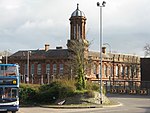Riccarton and Craigie railway station
1965 disestablishments in ScotlandDisused railway stations in East AyrshirePages with no open date in Infobox stationRailway stations in Great Britain closed in 1965Unbuilt railway stations in the United Kingdom ... and 1 more
Use British English from October 2017

Riccarton and Craigie was an unopened railway station serving the village of Riccarton and the distant hamlet of Craigie, both in East Ayrshire, Scotland. Built in 1902 and originally just called Riccarton, it was renamed in 1905.
Excerpt from the Wikipedia article Riccarton and Craigie railway station (License: CC BY-SA 3.0, Authors, Images).Riccarton and Craigie railway station
A71,
Geographical coordinates (GPS) Address External links Nearby Places Show on map
Geographical coordinates (GPS)
| Latitude | Longitude |
|---|---|
| N 55.5965 ° | E -4.4995 ° |
Address
Riccarton and Craigie
A71
KA1 4HW , Riccarton
Scotland, United Kingdom
Open on Google Maps








